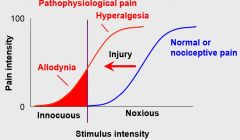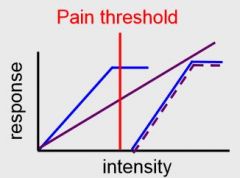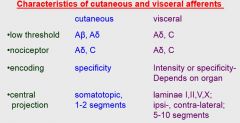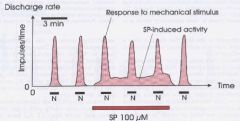![]()
![]()
![]()
Use LEFT and RIGHT arrow keys to navigate between flashcards;
Use UP and DOWN arrow keys to flip the card;
H to show hint;
A reads text to speech;
85 Cards in this Set
- Front
- Back
|
What is pain?
|
Unpleasant sensory and emotional experience associated with actual or potential tissue damage, or described in terms of such damage
|
|
|
Pain is always what?
|
Subjective (since it is unpleasant [if not, it’s not pain] and emotional [if it’s bothering you, there’s an emotional component to it])
|
|
|
What are the 3 components of pain?
|
1) Sensory (discriminative) [i.e. location, character, duration, intensity], 2) affective (motivational), and 3) cognitive (evaluative) [what are you going to do about it and how does your environment affect your perception]
|
|
|
how can one stimulus affect two different people?
|
may be incredibly painful to one person and hardly affect another - it is SUBJECTIVE and uniquely individual. so you cannot tell your patients how much pain they are in
|
|
|
what are some factors that pain depends on?
|
biological, psychological, and social factors. varies across and within populations
|
|
|
treatment of pain is often ____. why?
|
treatment is often inadequate because of 1) uncertain diagnoses, 2) social stigma, 3) lack of effective treatment and 4) lack of patient and clinical knowledge about how to best manage pain
|
|
|
you perceive pain and the neurobiological equivalent i.e. how the nervous system responds is ____
|
Nociception (e.g. you perceive pain from a cut, burn, tissue damage etc. and nervous system response is nociception)
|
|
|
you perceive hyperalgesia and the neurobiological equivalent is ____.
|
hypersensitivity in the nervous system
|
|
|
what is hyperalgesia? example?
|
heightened sensitivity to an already painful stimulus (e.g. a really hot shower is painful but a really hot shower when badly sunburned -> agony)
|
|
|
you perceive primary hyperalgesia i.e. at the site of the injury and the neurobiological equivalent is ____
|
peripheral sensitization (e.g. the reddened area around a paper cut)
|
|
|
you perceive secondary hyperalgesia i.e. away from the site of the injury and the neurobiological equivalent is ____
|
central sensitization
|
|
|
what happens with central sensitization?
|
an increase in excitability in dorsal horn neurons and further up in pain pathways in the brain
|
|
|
you perceive allodynia and the neurobiological equivalent is ____
|
allodynia does not imply a mechanism* (several hypotheses) term used to describe a clinical condition
|
|
|
what is an example of allodynia? when do you see it?
|
perception of pain to a normally non-noxious/non-painful stimulus e.g. lightly rubbing of the skin or blowing cool air may be perceived as intense, burning pain. often seen in nerve injuries
|
|
|
what is more common, hyperalgesia or allodynia?
|
hyperalgesia
|
|

explain
|
when you have an injury, you see a leftward shift in the stimulus-pain response function. so now a mild slap on the back e.g. on sunburned skin becomes much more painful. allodynia is where light touch produces a painful stimulus
|
|
|
what is the role of pain normally?
|
you can’t survive without “normal” or “nociceptive” pain -> it is animportant signal that something is wrong e.g. you need to protect injured area and let it heal. the curve should shift back to the right
|
|
|
what is pathophysiological pain? when does it occur?
|
in some cases, especially with nerve damage injury either in periphery or CNS, the curve may remain shifted to the left -> pathophysiological pain -> chronic pain -> pain becomes the disease e.g. more than three months
|
|
|
what happens in many chronic pain cases?
|
the pain has become the disease. the cause of the pain has gone away, and is no longer apparent, but there have been changes in the nervous system involving plasticity in the brain and nervous system. the curve stays shifted
|
|
|
in chronic pain, what other types of changes do you often see?
|
in psychological state and mood
|
|
|
as far as mood, pain and ____ go together. how do they interact?
|
depression and pain go together; which came first? they modulate one another
|
|
|
whether pain is good or bad depends on the ____
|
circumstances
|
|
|
Acute pain is ____ vs. chronic is _____
|
protective; it is a symptom of something else. Chronic pain is useless. it serves no useful purpose and can be thought of as a disease state itself*
|
|
|
as far as time scale, pain can be ____ or ____
|
acute / transient or chronic
|
|
|
some examples of transient pain are:
|
touching a hot coffee pot, pinprick (e.g. may cause withdraw reflex but does not last long)
|
|
|
what is the course of acute inflammatory pain typically like? what are some examples?
|
(chemical, sprains, breaks, minor burns, postoperative etc…) hurts for a couple of days, weeks, perhaps months but you will experience less pain as the injury heals
|
|
|
what are three categories of pathophysiological pain? describe its course
|
1) chronic inflammatory pain (e.g. arthritis), 2) neuropathic pain (diabetic, chemotherapy-induced) or 3) central pain (post-stroke pain) -> damage to the nervous system that does not go away; take a very long time, may last for years
|
|
|
5 types of pain include:
|
Somatic vs. visceral; Primary hyperalgesia vs. secondary hyperalgesia; Referred pain
|
|
|
Chronic pain can manifest in many forms (3 examples)
|
reflex sympathetic dystrophy, herpes zoster / post-herpetic neuralgia, ulcerative colitis
|
|
|
Pain is a ____ experience including ____, ____ and ____ components.
|
Pain is a multidimensional experience including sensory, emotional and cognitive components.
|
|
|
Hyperalgesia is ____ pain
|
hyperalgesia is increased pain
|
|
|
allodynia is ____ pain
|
new pain
|
|
|
cutaneous / somatic pain refers to pain from
|
skin, muscle, bone or joint
|
|
|
visceral pain refers to pain from
|
all of your internal organs e.g. reproductive, the GI tract, cardiovascular organs
|
|
|
size and speed of A-beta fibers?
|
larger, myelinated so fast conductance
|
|
|
size and speed of A-delta fibers?
|
smaller, myelinated, also fast
|
|
|
___ fibers are unmyelinated
|
C fibers are unmyelinated
|
|
|
where in your viscera can you feel low-threshold stimuli?
|
mostly you can’t but you can feel some in your esophagus, stomach, rectum
|
|
|
what does specificity encoding refer to?
|

one group that encodes innocuous stimuli (Aβ, Aδ), response increases as intensity increases until you reach the pain threshold. as you move into the noxious range, the second group of fibers fire
|
|
|
what does intensity encoding refer to?
|
when one afferent will encode the entire range from innocuous to noxious (e.g. some viscera fibers)
|
|
|
when do you feel noxious stimuli from the liver?
|
only when there is significant disease / pathology e.g. tumor
|
|
|
compare and contrast cutaneous with visceral pain
|

|
|
|
in the spinal cord, how are the cutaneous nociceptive afferents spread?
|
not spread out very far, they have relatively small terminal arborizations in the dorsal horn
|
|
|
describe the somatotopic organization of cutaneous nociceptive afferents in the SC in general
|
the lower extremities are more medial vs. the arms are more lateral (come in later)
|
|
|
where in the spinal cord is innervation from the toes?
|
come in through the DRG and terminate in the medial part of the dorsal horn at the lumbar enlargement.
|
|
|
as you move up and around the foot, what’s the somatotopic organization in the SC?
|
you move up and lateral around the horn and makes its way up to form the homunculus
|
|
|
what is the functional importance of the somatotopic localization of cutaneous afferents in the spinal cord?
|
this allows you to localize where the noxious stimulus occurs, what part of your body is hurt (e.g. step on a tack and hurt your heel vs. your toes); discrete map of projections
|
|
|
in the spinal cord, how are the visceral nociceptive afferents spread?
|
the axon comes in and sends off branches that project into the superficial and deeper dorsal horn as well as contralateral side; the rostral/caudal projection of the afferent is spread over 5-10 SC segments, “all over the place”; huge terminal arborization
|
|
|
what is the functional consequence of the dispersed visceral afferent projection in the SC?
|
you lose your somatotopic organization, you don’t know where the pain is exactly
|
|
|
how will your patients will feel belly pain?
|
more generalized abdominal / visceral pain; it’s poorly localized so you don’t know *where* the noxious stimulus causing your pain; you can’t localize it (e.g. ulcer could be anterior/posterior, gastric/duodenal etc.)
|
|
|
how many synapses do visceral afferent fibers synapse on?
|
hundreds if not thousands of neurons, and then you lose the ability to localize where the stimulus is coming from
|
|
|
how much of the DRG is visceral afferent vs. somatic afferents
|
visceral afferents make up AT MOST ~10% of DRG (fewer cells innervate the viscera) vs. 90% afferents make up somatic cells
|
|
|
how does innervation density vary with different parts of your body?
|
certain parts of your body allow you to discriminate better (e.g. fingertips and lips) vs. trunk of your body (with the 2-point measure); impact your perception of stimuli including noxious stimuli
|
|
|
why is visceral pain challenging?
|
you can’t really tell where visceral pain is coming from; can be difficult for patients -> worrisome and challenging for clinicians to know how to treat it
|
|
|
compare and contrast muscle afferents with visceral and cutaneous afferents
|
muscle afferents fall in-between; you may know the muscle (e.g. hamstring) so some localization but you don’t really know where in the hamstring the damage has occurred; their terminal arborizations are much larger than the cutaneous afferents but much smaller than visceral afferents; affects your perception
|
|
|
what is step 1 in a noxious stimulus evoking pain?
|
Step 1: Primary Afferent Nociceptor Signaling: Activation and Sensitization
|
|
|
what is activation?
|
activation is a stimulus that causes the primary activation to fire. i.e. you stimulate and you get a response
|
|

explain
|
applying substance P here gives you a lower response but the cells are still responding and applying the stimulus N still results in the firing i.e. activation
|
|
|
what is sensitization
|
sensitization is doing something that will increase the ability of the primary afferent to fire i.e. will lower the threshold or raise the response to a given stimulus intensity
|
|

explain
|
apply stimulus B and you get a response but after giving PGE2 (prostaglandin E2), you get a much greater response which eventually returns to normal / baseline
|
|
|
how are nociceptor activation and sensitization related?
|
Nociceptor activation does not always lead to sensitization and sensitization can occur without nociceptor activation
|
|
|
give an example of sensitization
|
when you get sunburned, the pain may go away after a bit but your skin may remain sensitized so if you get a slap on the back or take a hot shower, it hurts more; it gives you a much greater response
|
|
|
for the most part, how does activation work?
|
through ionotropic receptors i.e. receptors and channels that open and allow chemicals to run through them
|
|
|
what are the 4 categories of channels involved in activation?
|
mechanical, thermal, or chemical transducers and ligand-gated channels
|
|
|
what is Nav1.8?
|
a sodium channel found in nociceptive afferents
|
|
|
what is TRP-V1?
|
a receptor that responds to capsaicin, as well as heat and changes in pH; main receptor for spicy foods
|
|
|
what is TRP-M8?
|
receptor involved in cool sensation
|
|
|
what is TRP-A1?
|
also a receptor involved in cool sensation
|
|
|
what is P2X3?
|
a purinergic receptor
|
|
|
what is DRASIC?
|
an acid receptor, sense changes in pH
|
|
|
what are 7 stimuli involved in activation of nociceptive primary afferent terminals?
|
5-HT, ATP, Glu, ACh, H+, Capsaicin, Noxious heat
|
|
|
how do activators affect channels?
|
when they bind to the receptors they cause the channels to open up and allow influx of Na+ or Ca++ into the cell, which causes it to start to fire
|
|
|
what type of receptors does sensitization work through?
|
through G-protein coupled receptors i.e. 7 transmembrane proteins that bind to different chemicals and activate through GDP-alpha/beta subunit complexes -> GTP -> second messenger pathways (activating kinases)
|
|
|
when second messenger pathways are activated during sensitization what 3 things can happen downstream?
|
kinases can cause phosphorylation of ion channels that either 1) open ion channels (excitatory) or 2) close ion channels (inhibitory) or 3) activated voltage-gated, Ca++ activated channels to increase their activity
|
|
|
what are the effects of sensitization on depolarization?
|
through sensitization you can increase the amount of depolarization (initially caused by activation) or lower the threshold to achieve the same level of depolarization -> action potentials -> information goes to the spinal cord
|
|
|
what’s an example of inhibitory G proteins involved in nociception?
|
opioids, that work in the periphery, help reduce activation of Ca++ channels and work to activates K+ channels, which tend to hyperpolarize cells -> puts the brakes on the excitation
|
|
|
what are some members of the other large class of receptors?
|
activated by Growth factors (NGF), Hormones (e.g., cortisol, estrogens), Cytokines (IL-1β, TNFα, IL-6) i.e. chemicals released from site of injury or in response to infection
|
|
|
how does this third class (GF, hormones, cytokines) work?
|
slower (hours to days) but can lead to changes in transcription of receptors, ion channels and transmitters; can change responsiveness of primary afferent terminals; *can* act on longer-lasting scale to modulate how the primary afferent responds to different types of stimuli
|
|
|
noxious stimuli produce an ____ of chemicals that will activate and work at ____ different types of receptors
|
noxious stimuli produce an array of chemicals that will activate and work at all of these different types of receptors
|
|
|
Afferents use different ____ strategies depending on the ____ ____.
|
Afferents use different encoding strategies depending on the target tissue.
|
|
|
what is the consequence of more discrete central projections (terminal field in the spinal cord)?
|
contributes to stimulus localization.
|
|
|
what happens with divergent central projections?
|
leads to loss of somatotopic organization.
|
|
|
compare and contrast somatoptopic organization and localization of cutaneous, visceral and muscle input?
|
Cutaneous input is somatotopically organized, visceral input is not and is poorly localized. Muscle input is somewhere in between.
|
|
|
Afferents can be activated by what?
|
stimuli that bind or activate ligand-gated ion channels.
|
|
|
Afferents can be sensitized by what?
|
substances that bind metabotropic receptors (G-protein coupled receptors).
|

